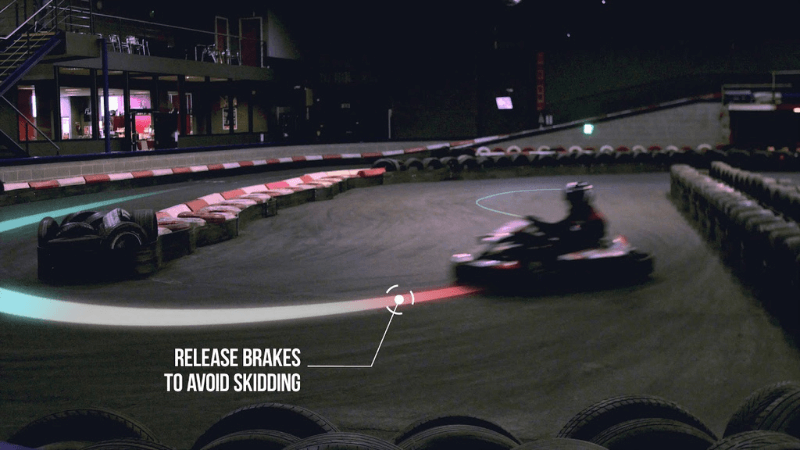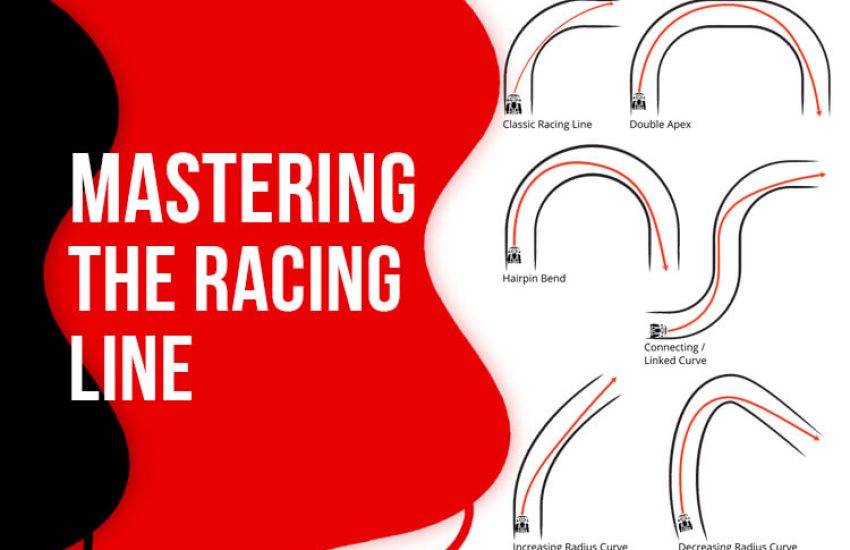Whether you’re an experienced racer or a novice, comprehending the complexities of the racing line is fundamental to achieving triumph on the circuit. So, what exactly is the racing line when it comes to go-karting?
The racing line denotes a kart’s ideal trajectory around a course, optimizing velocity while minimizing the distance traveled. It’s a strategic maneuver employed by professional drivers to gain an edge over their opponents and achieve the swiftest lap times conceivably.
By flawlessly executing the racing line, drivers can seamlessly maneuver through corners, sharply accelerate, and ultimately slice off valuable seconds from their lap times.
In the ensuing segments, we’ll delve into the various elements of the racing line and illustrate how to incorporate them into your driving technique to amplify your performance. So, let us plunge into the intricacies of the racing line and discover how to capitalize on it when go-karting.
Table of Contents
ToggleUnderstanding Go-Kart Racing Lines

The racing line in karting is the epitome of the perfect path a kart takes around a course to optimize speed while concurrently minimizing the distance traveled.
It necessitates adept positioning of the kart to achieve the paramount possible cornering speed, acceleration, and braking. To comprehend the intricacies of the racing line, it’s imperative to gain insight into its distinct components.
Acquiring proficiency in the racing line is a prerequisite to excelling in karting. Employing the racing line technique enables drivers to enhance their lap times and augment their prospects of emerging victorious in races.
It empowers drivers to nonchalantly maneuver through corners, accelerating expeditiously out of them and making them faster on the track.
Types of Corners
Karting tracks have an abundance of corners, and some of the most commonplace types are hairpins, chicanes, sweepers, and esses.
- Hairpin corners are acute bends that require drivers to decelerate significantly before entering and swiftly accelerating out of them.
- Chicanes comprise a sequence of corners, customarily entailing a progression of left-right or right-left turns.
- Sweepers are extensive, meandering corners that mandate a smooth and stable line to retain the maximum speed feasibly.
- Esses entail a series of zigzagging turns that demand rapid modifications in direction.
The configuration of the track has a substantial effect on the racing line technique. Tracks with numerous acute corners, like hairpins, mandate drivers to brake vigorously before entering the bend and then swiftly accelerate out of them.
Conversely, tracks with extensive, hard corners, such as sweepers, necessitate a seamless and stable line to maintain speed throughout the turn.
By tweaking the racing line to match the track layout, you can ameliorate your lap times and enhance their prospects of prevailing in races.
Factors Affecting the Racing Line
Various factors, including speed, grip, and kart setup influence the racing line technique.
- Speed plays a pivotal role in determining the racing line. As the kart accelerates, the racing line needs to be broader to ensure that the kart remains under control and doesn’t slide out of the corner. As the speed increases, you must exhibit greater care and precision when approaching corners to avoid losing control of the kart.
- The grip is another critical factor affecting the racing line. The grip of the track surface and the kart tires is significant. A track with high-grip permits drivers to take corners at higher speeds, while a track with a low grip necessitates slower cornering speeds to maintain control. The grip of the kart tires also affects the racing line, with softer tires delivering more grip and harder tires providing less grip.
- Kart setup is another vital consideration for the racing line. The kart’s weight distribution, tire pressure, and suspension settings all impact how the kart performs on the track. A well-balanced kart with the right setup can make it easier for drivers to correctly hit the racing line components and achieve faster lap times.
What Are The Different Types Of Racing Lines

The Ideal Racing Line
The art of kart racing demands an intimate understanding of the elusive ideal racing line, a concept that is crucial to achieving optimal performance. In essence, the ideal racing line is a meticulously calculated route that balances the need for speed with efficiency, which isn’t always synonymous with taking the shortest path.
A truly skilled driver understands that mastering the ideal racing line is the key to maintaining unyielding speed and momentum throughout the race, ultimately resulting in faster lap times and significantly bolstered chances of achieving victory.
The ideal racing line consists of entry, apex, and exit points that you must hit precisely to maximize speed and momentum. The entry point is where the driver begins to slow down before entering the corner, while the apex is where the driver takes the shortest possible route through the corner.
Finally, the exit point is where the driver starts to accelerate out of the corner.
The Defensive Racing Line
One popular technique employed by drivers is the defensive racing line. Essentially, this involves taking a broader and slower route around the track to impede the progress of any competitors attempting to overtake.
By positioning their kart on the outermost edge of a corner, the driver effectively creates a formidable barrier that makes it exceedingly difficult for others to sneak by on the inside. Indeed, mastering this technique can make all the difference in a close race.
While the defensive racing line can be an effective tactic for maintaining position, it has some drawbacks. Namely, taking a wider and slower route sacrifices speed and acceleration, making it more challenging to stay ahead of other drivers.
As a result, you must weigh the benefits and drawbacks of the defensive racing line and use it judiciously to achieve the best possible outcome.
The Overtaking Racing Line
Unlike the ideal racing line, a tried-and-true path around the track optimized for speed and efficiency, the overtaking racing line involves taking a different route to overtake other drivers.
The overtaking racing line can take many forms, including wider or tighter lines than the ideal one, all to create a better exit angle out of a corner or set up a passing maneuver on a straightaway. To successfully execute the overtaking racing line, you must analyze the track layout and carefully plan your moves to find the best path to overtake the kart.
Moving off the ideal racing line can result in slower lap times and reduced performance, making it essential for drivers to carefully weigh the benefits and drawbacks of the overtaking racing line before committing to it.
How To Find The Racing Line

Identifying the Apex and Exit Points
When it comes to kart racing, identifying each corner’s apex and exit points is critical for mastering the art of the racing line. The apex point is where the kart is closest to the inside of the corner before turning towards the exit. Conversely, the exit point is when the kart leaves the corner and accelerates toward the next section of the track.
By hitting the apex and exit points at the right angle, you can take the most efficient path around the track, maximizing your speed and minimizing your lap times. This makes you faster overall and helps you set up overtaking maneuvers or defend your position against other drivers.
Drivers use a variety of visual markers such as braking points, curbs, or barriers to identify the apex point of a corner. The exit point is typically at the end of the corner and may involve accelerating towards a straightaway or preparing for the next corner.
By carefully studying the track layout and analyzing each corner, you can gain a crucial advantage over your opponents and master the art of the racing line in karting.
Practice Drills for Mastering the Racing Line
Driving enthusiasts who aspire to execute the perfect racing line can enhance their skills by engaging in various practice drills.
- One of the most widely-used and popular drills is the “slow in, fast out” technique. This drill requires drivers to approach corners at a reduced speed, intending to nail the apex before accelerating out of the corner with lightning speed.
- The “figure 8” drill is another excellent exercise that lets drivers practice the ideal racing line while weaving through a series of tight, tricky corners.
- For those seeking a more comprehensive challenge, time trials, and race simulations can help them improve their skills.
By repeating the ideal racing line over and over again, you can develop the muscle memory and instinct necessary to execute it with ease and precision.
Also Read: Essential Go-Karting Techniques
To extract the maximum benefit from their practice drills, you should zero in on specific components of the racing line, such as hitting the apex point or exiting corners at the optimal angle.
It’s also essential to diversify your practice routines by tackling a range of different types of corners, from hairpin turns to high-speed chicanes. This will help you cultivate a versatile, well-rounded skillset that withstands the most challenging racing conditions.
Analyzing and Refining Your Racing Line
Enhancing your on-track performance requires a comprehensive approach that thoroughly analyzes your racing line. This essential practice lets you pinpoint areas where you might be losing precious seconds and make the necessary tweaks to maximize your performance.
One of the most reliable and efficient ways of analyzing your racing line is by leveraging cutting-edge video analysis software. This advanced technology empowers you to scrutinize your driving technique in minute detail, examining everything from your throttle and brake inputs to your steering and cornering maneuvers.
Alternatively, you can draw insights from telemetry data gleaned from your kart, which provides a wealth of valuable performance metrics to help you identify areas for improvement.
Refining your racing line is a crucial step in boosting your on-track performance. Here are some expert tips to help you do so efficiently and effectively.
- Break it down: Instead of simultaneously enhancing your entire racing line, concentrate on a single corner at a time. By fragmenting it into smaller sections, you can more precisely pinpoint areas that require adjustment, leading to a more refined and effective racing line.
- Try different approaches: Don’t be afraid to experiment with various approaches to each corner to identify what works best for you. You may discover that braking earlier or later, taking a wider or tighter line, or accelerating earlier or later can shave valuable seconds off your lap times.
- Practice makes perfect: When it comes to mastering the racing line, repetition is the key to success. Devote ample time and energy to practicing the same corner repeatedly until you feel confident in your technique. Then, move on to the next corner, rinse, and repeat the process.
Final Thoughts
To leverage the racing line and maximize your on-track performance, it’s crucial to comprehend the various types of corners on a karting track and how they can impact your racing line.
While the ideal racing line is the most efficient way to tackle corners, there are times when a defensive or overtaking racing line may be more appropriate, depending on the situation.
To master the racing line, it’s important to regularly practice and incorporate drills that hone your ability to identify and perfect apex and exit points.
Don’t forget to regularly analyze and refine your racing line technique using video analysis software and telemetry data from your kart. With ample practice and diligent analysis, you can develop a refined racing line that suits your unique driving style and propels you to success on the track.



